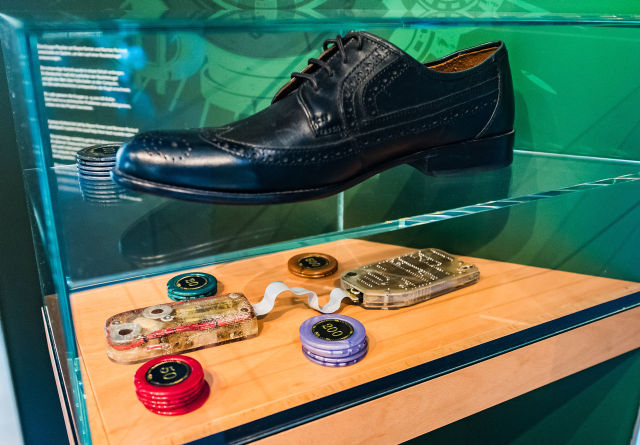The first computer you could walk on is on display at the Heinz Nixdorf MuseumsForum. The shoe computer had its debut at the beginning of the 1980s in a Las Vegas casino when a group of freaks from California tried to break the bank.
A student creation
It took several years to produce the device. The students ran into technical and physical problems again and again before they were finally able to integrate the electronics into a shoe. But with it, the computer was able to improve on mere chance when the students played roulette. It analysed the motion of the ball and predicted the octant of the wheel where the ball was likely to land.
The builder of this curious shoe and its internal technology was Doyne Farmer, a member of a group of students – the Eudaemons – at the end of the 1970s in Santa Cruz, California. Their aim was to come up with a way to use technical and scientific know-how to help to determine the location where the ball would land. The result was a computer that was packed into a hollowed-out loafer. This achievement was made possible by the progress and miniaturisation of electronics.
At the time, most computers were so big that they could be set up on a desk, but now the whole computer could be compactly designed with the microprocessor of a KIM set. Nonetheless, it took years of effort filled with technical setbacks before the shoe computer could finally undergo its “trial by fire” in November 1981 at the Sundance in Las Vegas.
In the casino
Doyne Farmer’s shoe contained a computer, a toe-operated switch, batteries and a transmitter. He clocked the motion of the ball, used his toe to feed the data to the computer and sent the result via toe transmission to his buddy Thomas Bass, the player who was standing right next to him and placing the jetons on the gameboard.
The computer identified the octant of the wheel where the ball was likely to land, and Bass placed the bets. Bass received the signal in his right shoe, which was equipped with a number of vibrators. In addition to the technical functions, the game observer needed to have agile toes and the player needed a sensitive heel.
Good fortune with the “13”
Everything seemed to work well. The jetons piled up in front of them after a successful bet on “13”. But then problems arose. The vibrators in the heel of Bass’s shoe began to twitch arbitrarily and had no recognisable signal. The nervous players tried a few more games and then left the Sundance. The cause of the problem was quickly found. The radio transmission between the shoe computers was significantly disrupted by the electronic devices in the casino. Overhauling the computer would have required months of work and the team no longer wanted to do it; they consoled themselves with the roughly $10,000 that they won.
Most of them then launched academic careers in the new area of chaos research or, like Doyne Farmer, went into the financial industry, where he used the knowledge he gained in the casino in the big field of financial mathematics.
